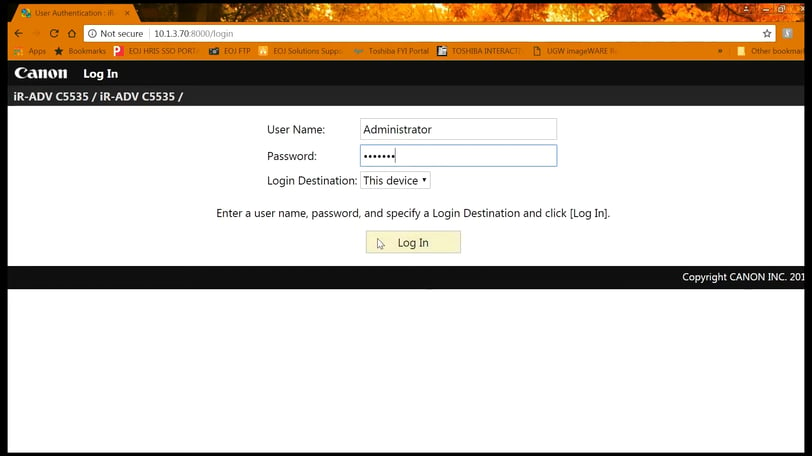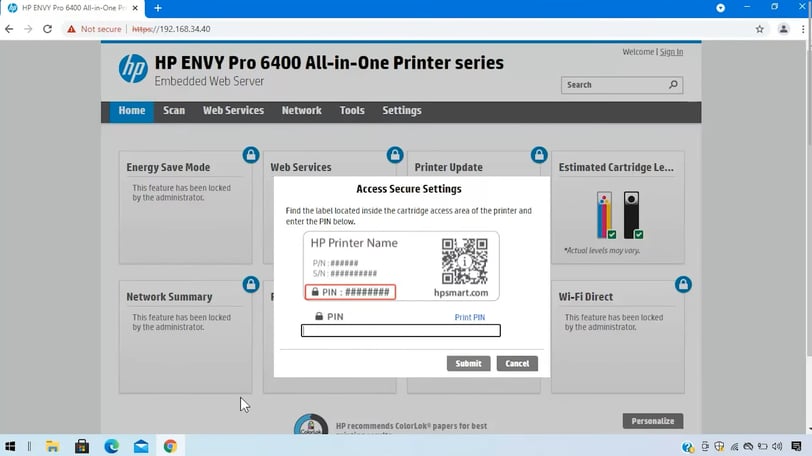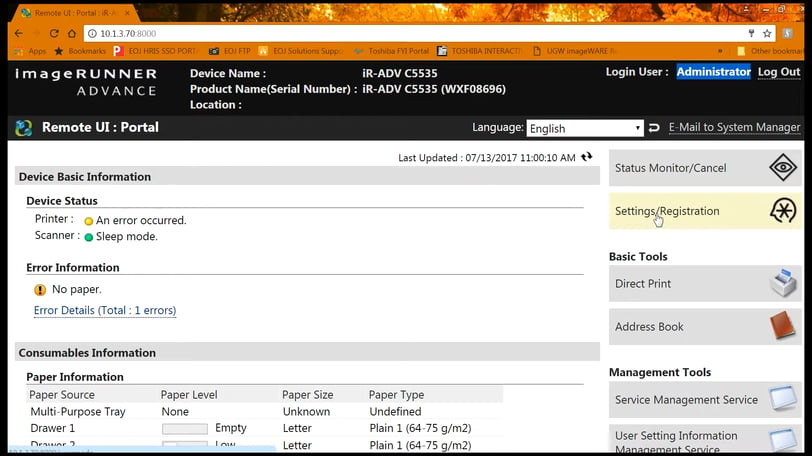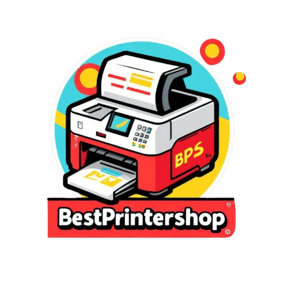What is a Printer Portal? Benefits, Features, and How to Use It
Discover what a printer portal is, why you need it, and how it helps optimize printing, reduce costs, and boost productivity for businesses and organizations.
Praveen Kumar - Canon Printer Specialist
1/13/20258 min read


Introduction: Printer Portal?
Ever felt frustrated juggling multiple printers, checking on their status or managing print tasks across a busy office? Printer management can be a messy, time consuming task that eats into your productivity.
Imagine being in a deadline rush and your printer is jammed or out of toner and you have no idea how to fix it. Or maybe you’re managing a network of printers and have no way to centralise management or troubleshoot issues.
These little annoyances can add up to major productivity blockers. That’s where Printer Portals come in. A printer portal is a centralised, easy to use interface that makes printer management, troubleshooting and monitoring a breeze. Whether you have one printer or a whole fleet, a printer portal gives you the tools and visibility to get things done faster.
1. What is Printer Portal?
A Printer Portal is a web-based or software-driven platform that allows you to manage and monitor all your printers in one place. Imagine a command center for all your printing needs. No more scattered device specific settings, everything is centralized.
Key Features of a Printer Portal:
Printer Monitoring: Real-time updates on printer status, toner levels, paper supply, error messages.
Task Management: View, pause, cancel or prioritize print jobs.
User Management: Set permissions, track usage, manage access for multiple users.
Reporting: Print usage, cost, efficiency reports.
Remote Access: Manage printers from anywhere via cloud.
For multiple printers or remote teams, a printer portal is a must have.
2. Why Do We Need a Printer Portal?
Managing printers is easy until you have to scale, multiple devices or troubleshoot frequently. This is where a Printer Portal comes in. Here’s why:
1. Centralized Management
Without a printer portal, managing multiple devices means interacting with each one individually which can be a time suck. A printer portal brings all your devices into one dashboard so you can monitor and control them easily.
Example:
An office with 10 printers across departments. Instead of walking to each device to check status or fix issues you can just log in to the portal and see their status instantly.
2. Minimize Downtime
Printer issues like paper jams, low toner or offline status can stop productivity. With a printer portal you get real-time alerts and troubleshooting tips to fix issues before they get out of hand.
Benefit:
This proactive approach helps businesses keep workflow going especially in time sensitive industries.
3. Cost Control
Printing can be costly when it’s unmanaged. A printer portal gives you insights into:
Usage Statistics: See how much is being printed and by whom.
Cost Analysis: Where to cut waste or set limits.
Supply Management: Stay on top of toner, paper and other consumables.
Example:
An organization reduced printing costs by 25% after using a printer portal to monitor personal printing and set user quotas.
4. Security
Printers store sensitive data from financial reports to legal documents. A printer portal helps with security through:
Secure print release (only authorized users can retrieve documents).
User authentication for access.
Logs to see who printed what and when.
5. Eco Friendly Printing
If sustainability is important to you, printer portals enable:
Double sided printing as default.
Monitor and reduce unnecessary print jobs.
Detailed reports to encourage better usage.
6. Scalability for Business
As your business grows so does the complexity of managing resources like printers. A printer portal can scale with your needs, add more devices, locations and users without the chaos.
In Summary:
We need printer portals because they simplify printer management, reduce costs, improve security and ensure smooth operations. For individuals and businesses it’s too big to ignore.


4. How to Open a Printer Portal?
Opening a printer portal is easy whether it’s for one printer at home or an entire office network. Here’s how.
1. Check if Your Printer has a Portal
Not all printers have a portal. Check:
Your printer manual or specs to see if it’s supported.
If the printer has a dedicated IP address (many network printers do).
Whether your printer supports cloud-based portals like HP Smart, Epson Connect, or Canon Print.
2. Connect Your Printer to the Network
A printer portal usually requires the device to be on the same network as your computer or mobile device.
For Wi-Fi Printers: Go to the printer’s settings menu and connect to your network.
For Wired Printers: Make sure the printer is connected to your router via an Ethernet cable.
3. Open Printer Portal via Web Browser
Most printer portals can be opened via a browser. Here’s how:
Find the printer’s IP Address:
Print a network configuration page (instructions vary by brand).
Or find the IP address via your computer’s control panel or network settings.
Open your browser and type the IP address in the address bar (e.g., 192.168.1.100).
You’ll be taken to the printer’s web portal.
4. Log in to the Portal
Some printer portals require a username and password:
Default credentials are in the printer manual.
If you changed the login credentials, use those.
Reset the printer if you forgot the login credentials.
5. Explore the Dashboard
Once logged in you’ll see a dashboard with various options depending on your printer:
Printer status and settings.
Print job management.
Device and user controls.
6. Use a Mobile App (Optional)
Many brands have mobile apps to open the printer portal:
Download the app (e.g., HP Smart, Canon PRINT, or Brother iPrint&Scan) from your device’s app store.
Follow the in-app instructions to connect to your printer.
Help:
Can’t find the printer portal?
Make sure your printer and device are on the same network.
Restart both the printer and your router.
Connection problems?
Check if the printer’s firmware is updated.
Check firewall or antivirus settings that may block access.
3. Why a Printer Portal?
Now that we’ve covered why you need a printer portal, let’s look at why using one is a good idea for everyone.
1. Easy Printer Management
A printer portal simplifies managing multiple devices. It’s a one-stop-shop where you can:
See all printers.
Monitor live status.
Access all settings without having to navigate device menus.
Example:
Imagine being able to adjust printer settings for all your office printers from one dashboard instead of each one individually.
2. Time
Time is precious and printer portals are designed to save it. They simplify things by:
Letting you prioritise urgent print jobs.
Allowing remote troubleshooting and maintenance.
Sending automated alerts for potential issues (e.g. low toner or paper jams).
Scenario:
A manager sees a low toner alert in the portal and orders a replacement before the printer runs out, so the project isn’t interrupted.
3. Collaboration
Printer portals make teamwork easier by supporting multiple users. They let:
Printer sharing across teams.
Role-based access (e.g. restrict high-cost colour printing to specific departments).
View job history for transparency.
Example:
In a co-working space, users can queue up their print jobs remotely without having to physically interact with the printer, reducing disruptions.
4. Cost Savings
Printer portals help you make smarter decisions and cut unnecessary costs by:
Setting printing limits for users.
Analyse monthly usage to find cost saving opportunities.
Enable eco-friendly options like duplex printing.
5. User Experience
For the end user, a printer portal is simple and user-friendly, even for those not tech-savvy. Features like mobile access and simple troubleshooting guides make it seamless and hassle-free.
6. Cloud Integration
Modern printer portals often integrate with cloud services like Google Drive, Dropbox and Microsoft OneDrive. This means users can print directly from these services without having to download the file locally.
7. Future Proofing
As technology moves forward, so do printer portals. Many solutions get regular updates to keep up with new printers, operating systems and security protocols.
Why It Matters:
Investing in a printer portal today means you’re prepared to adapt to tomorrow’s needs without overhauling your system.


5. What Do We See in a Printer Portal?
Once you’ve successfully opened the printer portal, you can explore a wide array of features that help monitor and control your printer’s performance. Printer portals are designed to provide essential tools and insights at your fingertips. Let’s dive into the common sections and features available in most printer portals.
1. Printer Status Overview
The first thing you’ll encounter is a summary of your printer’s current status. This section typically provides real-time updates on:
Ready or Offline: Indicates whether the printer is available or facing issues (e.g., offline or out of paper).
Toner or Ink Levels: Visual gauges show remaining toner or ink levels in each cartridge to help plan replacements.
Paper Tray Status: Displays whether the paper tray is adequately stocked or needs refilling.
Error Messages: Highlights issues like paper jams, low ink, or connectivity errors.
This overview ensures you stay informed about the printer’s health, helping prevent interruptions during important tasks.
2. Print Queue Management
The print queue section lists all active print jobs, providing control over ongoing and scheduled tasks. Key features include:
View Active Jobs: Monitor the status of each print job (e.g., printing, paused, or completed).
Pause or Cancel Jobs: Manage stuck or unnecessary jobs with ease.
Prioritize Jobs: Reorder the print queue to ensure critical tasks are printed first.
Benefit: Effective queue management minimizes delays and ensures a smooth workflow.
3. Job History and Logs
Printer portals often maintain a history of past print jobs, offering valuable insights like:
User Information: Identifies who initiated each print job.
Job Type: Tracks whether prints were color or black-and-white, and the document type.
Date and Time: Logs when jobs were completed.
This feature is particularly useful for tracking usage, reporting, or cost management in business environments.
4. Settings and Configuration
The settings section allows you to customize your printer’s functionality, including:
Network Settings: Manage Wi-Fi setup, IP address configurations, or connect additional devices.
Paper Size and Type: Adjust default settings based on the media being used (e.g., letter-sized paper or glossy photo paper).
Print Quality Settings: Modify resolution, color preferences, and duplex printing options.
These settings help optimize the printer for your specific needs and environment.
5. User Management
For shared printers, user management features ensure better control and resource allocation:
Permissions: Limit access to certain features, such as color printing or high-volume jobs.
Usage Monitoring: Track individual or departmental print usage to identify heavy users or inefficiencies.
This is especially beneficial in larger organizations where controlled access is crucial.
6. Reports and Analytics
Many printer portals offer robust reporting tools to monitor costs and usage patterns:
Cost Per Print: Analyze printing costs, including ink, toner, and paper consumption.
Usage Trends: Understand printing habits across users or departments to optimize budgets.
Environmental Impact: View metrics on paper and toner usage to promote sustainable practices.
Pro Tip: Regularly reviewing reports can uncover ways to reduce costs and improve efficiency.
7. Remote Access and Cloud Integration
Modern printer portals often support remote access and cloud-based printing for added convenience:
Remote Monitoring: Manage printer settings and monitor activity from anywhere.
Cloud Printing: Print directly from services like Google Drive, Dropbox, or OneDrive.
Mobile Printing: Send print jobs via smartphone or tablet.
This flexibility is invaluable for businesses with remote teams or hybrid work setups.
Summary: Who Benefits from Printer Portals?
In conclusion, printer portals are an invaluable tool for a wide range of industries and businesses. From large corporations to small startups, educational institutions, healthcare providers, government agencies, and retail businesses—every type of organization can benefit from the convenience, cost savings, and efficiency that a printer portal provides. These portals offer centralized control, real-time monitoring, usage tracking, and improved productivity, making them essential for modern-day printing management.
Insights
Explore the latest in printer technology and tips.
Resources
Support
contact@bestprintershop.com
+918920029543
© 2024 BestPrinterShop . All rights reserved.
